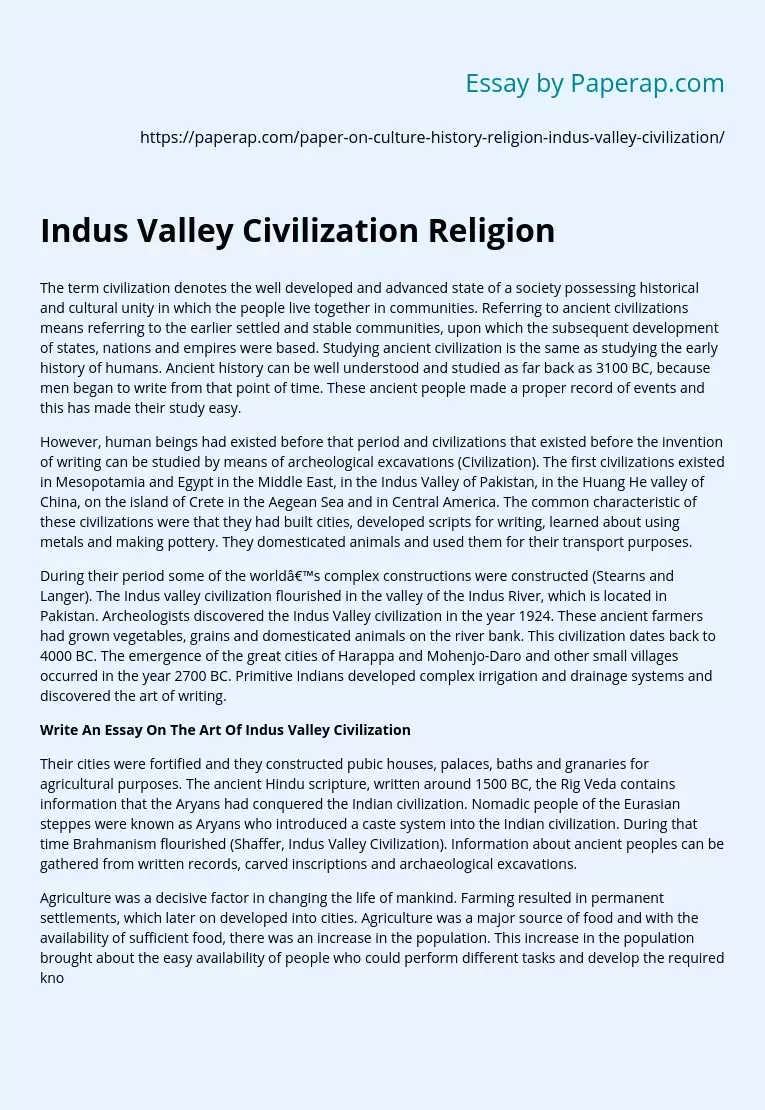Indus Valley Civilization Religion
The term civilization denotes the well developed and advanced state of a society possessing historical and cultural unity in which the people live together in communities. Referring to ancient civilizations means referring to the earlier settled and stable communities, upon which the subsequent development of states, nations and empires were based. Studying ancient civilization is the same as studying the early history of humans. Ancient history can be well understood and studied as far back as 3100 BC, because men began to write from that point of time.
These ancient people made a proper record of events and this has made their study easy.
However, human beings had existed before that period and civilizations that existed before the invention of writing can be studied by means of archeological excavations (Civilization). The first civilizations existed in Mesopotamia and Egypt in the Middle East, in the Indus Valley of Pakistan, in the Huang He valley of China, on the island of Crete in the Aegean Sea and in Central America.
The common characteristic of these civilizations were that they had built cities, developed scripts for writing, learned about using metals and making pottery. They domesticated animals and used them for their transport purposes.
During their period some of the world’s complex constructions were constructed (Stearns and Langer). The Indus valley civilization flourished in the valley of the Indus River, which is located in Pakistan. Archeologists discovered the Indus Valley civilization in the year 1924. These ancient farmers had grown vegetables, grains and domesticated animals on the river bank.
This civilization dates back to 4000 BC. The emergence of the great cities of Harappa and Mohenjo-Daro and other small villages occurred in the year 2700 BC. Primitive Indians developed complex irrigation and drainage systems and discovered the art of writing.
Write An Essay On The Art Of Indus Valley Civilization
Their cities were fortified and they constructed pubic houses, palaces, baths and granaries for agricultural purposes. The ancient Hindu scripture, written around 1500 BC, the Rig Veda contains information that the Aryans had conquered the Indian civilization. Nomadic people of the Eurasian steppes were known as Aryans who introduced a caste system into the Indian civilization. During that time Brahmanism flourished (Shaffer, Indus Valley Civilization). Information about ancient peoples can be gathered from written records, carved inscriptions and archaeological excavations.
Agriculture was a decisive factor in changing the life of mankind. Farming resulted in permanent settlements, which later on developed into cities. Agriculture was a major source of food and with the availability of sufficient food, there was an increase in the population. This increase in the population brought about the easy availability of people who could perform different tasks and develop the required knowledge to construct complex structures. This surfeit of food enabled the development of professions and trades in addition to agriculture (Guisepi).
Agriculture requires a considerable amount of water and the main sources of water that were available to the ancient people were the rivers, streams and rainfall. Thus, the very first civilizations flourished along the river banks. Subsequently, people began to harvest rain water in the rainy season. The development of most of the ancient civilizations was in this fashion. The increase in the population brought about the development of communities into villages. Since, other trades were also prevalent; there was considerable development in the manufacture of goods and in the arts.
Initially, these people stored food in animal skin gourds, which were later replaced with pottery. They learned to weave cloth from wool and flax and built houses with brick, stone and wood (Guisepi). Ancient people studied the movement of planets to determine the seasons. Further, the science of mathematics was developed as calculations were required to arrive at a correct decision. Later on they learned how to create calendars, which helped them to calculate the onset of the seasons and they divided the land among themselves for farming purposes and social reasons.
Moreover, they learned to measure the land and the seeds and grains that they produced. Further, it was required to maintain a record of the measurement of various objects for future needs. Writing was invented as it became necessary to record events in the form of letters. Prior to the invention of writing, people had recorded their activities in the form of pictures and objects representing their intentions. Egyptian hieroglyphics is the best example of this ancient writing system based on pictures and most of the early writings were inscribed on stone tablets (Green and Black).
Indus Valley Civilization Religion. (2019, Dec 05). Retrieved from https://paperap.com/paper-on-culture-history-religion-indus-valley-civilization/

